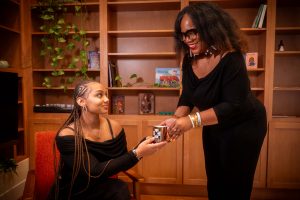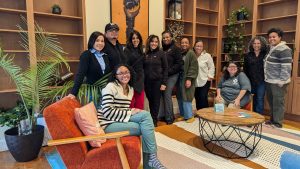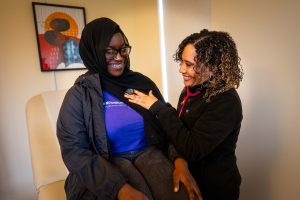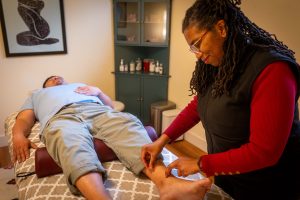“What we’re building is not mass-manufactured healthcare. It’s relational healthcare. It’s community-owned healthcare.”
Danisha Jefferson-Abye had not one, but two thriving careers. As a massage therapist, she delivered patient-centered care. As a community organizer, she led campaigns for social justice. She wondered, though, how to meld her passions for societal and personal healing. Then 2020 happened. Amidst a global pandemic and national calls for racial justice, she knew it was the right time to found the Tubman Center for Health and Freedom. Today, Tubman Health leads policy and advocacy, conducts community-driven research, and serves patients at two South Seattle-based clinics. With its third clinic slated to open in 2027, Tubman Health is scaling its approach.

Jefferson-Abye explained, “We know what makes us well, we know what we want, we know what we need, and the wisdom and the medicine exist in our communities. And so, what would it look like if we took an organizing approach to our health, wellness, and freedom and liberation? I took a step back and thought about what it would take to reimagine healthcare and wellness in our communities.”
After a remarkable 20-year career in organizing around health policy, Jefferson-Abye went back to school for her MPH in Health Systems and Population Health in 2020. She also began building Tubman Health. Today, there happens to be four UW School of Public Health alumni on Tubman’s core staff.
“Our connection with UW runs strong,” noted Tubman’s Public Affairs Manager, Karina Patel (UW Public Health ’21).
By community, for community
Jefferson-Abye has deep roots in South Seattle, home to many immigrants and communities of color which have long been marginalized by mainstream systems. She knew her neighborhood needed innovative health solutions: city-wide data shows that residents fare worse on health metrics, in part due to heightened industrial and transportation-related pollution from the historical redlining and housing discrimination that occurred in Seattle, as well as racism and lack of access to trustworthy healthcare.

“I grew up in South Seattle, and I used to walk right by the building that now houses our second clinic on my way home from school every day. This is my community. This is my neighborhood. This is why we are here,” said Jefferson-Abye. “We were really intentional with remembering who this organization belongs to, who it is for, and who we are doing this work with.”
One of Tubman Health’s core principles is that community-generated solutions are already out there; the medical establishment just needs to be willing to listen. Tubman Health’s Director of Research & Evaluation, Amanda Knights-Shi, a Health Systems and Population Health (HSPOP) MPH alum, wanted to be a part of hyper-local, grassroots healthcare.
“People know what they want for their healthcare, and in mainstream medicine, patient wishes aren’t always listened to. Keeping things grounded in community, keeping the community solutions, and keeping everything local is really, really important, because what we’re building is not mass-manufactured healthcare. It’s relational healthcare. It’s community-owned healthcare.”
Reimagining the doctor’s office
Tubman Health’s community clinic, the Healing House in South Seattle, emerged from a three-year design process using their unique Community Design methodology.
Phase 1 of Tubman Health’s Community Design process included:
- 24,000+ touchpoints from community members across the Puget Sound region from a mixture of projects and engagements;
- More than 15 community design sessions open to the community;
- 21 interviews with healthcare providers and additional patient simulations to cultivate the care that our community seeks.

Tubman Health Research Associate Tiara Ranson (UW Global Health MPH ’22) recalls inviting community members to engage with the Mental Health Vision Board, an arts-based research board labeled with various care modalities to define the care that they seek (movement, meditation, alternative medicine, art therapy, etc.).
“We really think out of the box when it comes to doing our heart-forward, emancipatory work,” Ranson explained.
Imagine stepping into a doctor’s office. What do you see, hear, and smell? For many Americans, the experience can be sterile, cold, and alienating. With results from its comprehensive Built Environment Design Report, Tubman set out to change not only the type of care that they delivered, but reimagining the settings in which care was given.

Again and again, community members called for natural elements (light, water, greenery), a balance between privacy and openness, community-based art, and other retreat-esque features that promoted wellness. These dreams and visions from community are realized at the Healing House, where staff warmly welcome patients and offer them a place of healing, respite, and healthcare.
“We’ve created healing spaces and a model of care where community members can let their guards down and come as they are—where they can expect to be met with love and deep care, and where their full selves are centered,” said Jefferson-Abye.
Community feedback also informed Tubman’s holistic care model. Tubman offers primary care and mental healthcare in addition to traditional medicine, such as acupuncture and massage. At Tubman Health, Western and alternative medicine are treated “on an equal footing,” said Patel.
Integrating care, research, and advocacy
The Tubman Health team has sought to shake up research just like they’ve shaken up healthcare.
“We think it’s critical that we tell our own stories, that we capture our own data,” explained Jefferson-Abye. “We know that that is a void. We know that the studies that are oftentimes getting funded are not led by community members who know how to ask the right questions, interpret data appropriately, and report it out in a way that is useful to community members.”
To fill that void, Tubman Health has produced several studies, including investigations of equitable payment systems. At the Healing House, the organization will be conducting a clinical trial and documenting the effectiveness and implementation of its model of care. For Knights-Shi, every focus group, policy brief, and clinical trial is intended as a model for the rest of the state, and indeed, the country.
“We are really documenting everything to make sure that other communities have the tools to build upon what we’re building as they work towards their collective health liberation,” she explained.
What’s next? The team will keep dreaming with community. Tubman Health’s third and largest clinic is set to open at the Rainier Beach light rail station in 2027 and will have the capacity to serve 12,000 patients. It will also have facilities open to the broader community. For the team, their North Star is clear. “We go back to Harriet Tubman,” said Patel. “She was a nurse and a healer, but also an abolitionist and a suffragist throughout her life. She embodied that intersection between direct clinical care and systemic change.”